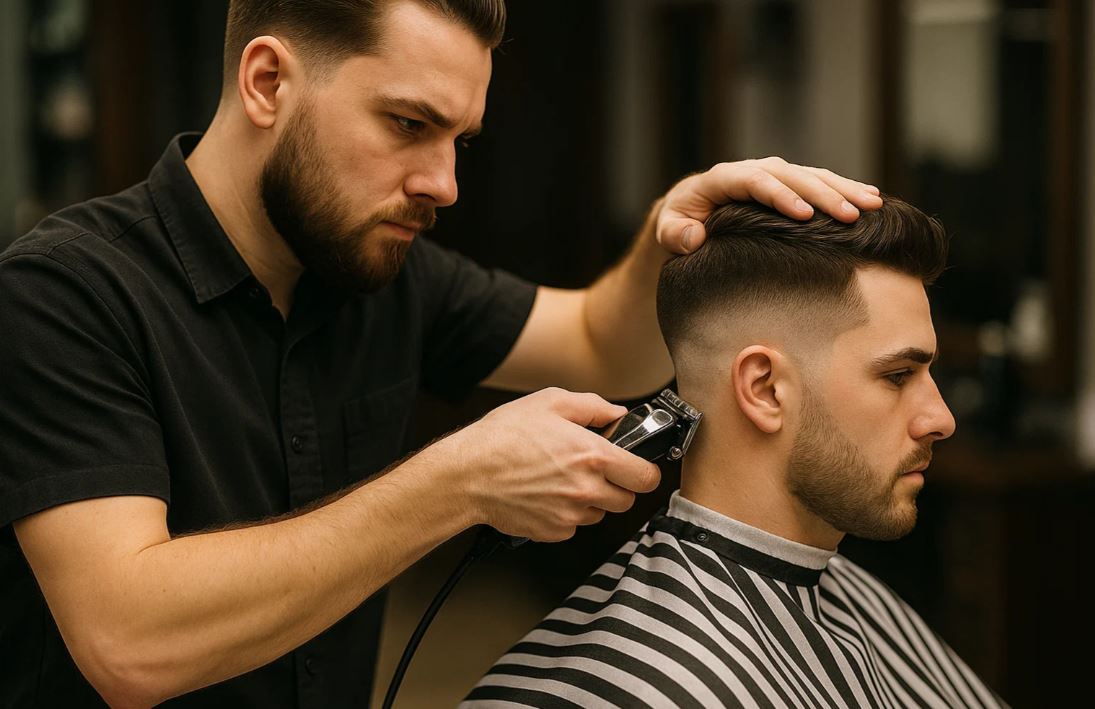Master the art of the taper fade haircut style: styles, techniques, care, and pro tips all in one definitive guide.
If you’ve ever sat in a barber’s chair wondering how to describe that perfect haircut, one that blends the sides seamlessly into the top, gives shape without harsh lines, and still looks fresh a few weeks later, then the taper fade haircut style is what you’ve been chasing. Your personal style matters just as much as the cut itself. In this article, I’m not just going to walk you through the basics, I’m going to share insights, pitfalls, trade-offs, styling hacks, and insider tips that you probably won’t find in every other guide.
What You'll Discover:
What Exactly Is a Taper Fade?
Think of a taper fade as a hybrid between a taper and a fade, but leaning more into the subtlety of a taper with the sharpness of a fade. It’s a gradient: hair longer at the top, shorter toward the sides and nape. The key difference compared to a pure fade is that the shortest portion doesn’t always go completely bald (unless you want it to). The taper fade blends into the natural hairline rather than aggressively disappearing into skin.
A pure taper usually means hair gradually shortens toward the edges but doesn’t necessarily “drop off.” A fade more aggressively reduces length and often ends in near-skin, especially in “skin fades.” The taper fade occupies the sweet zone in-between: more contrast than a classic taper, but less stark than a full fade.
Why is this useful? Because the taper fade can keep some structure (you retain shape) while giving you that modern, fresh finish.
Why It’s So Popular (and Why It Endures)
What makes the taper fade more than a passing trend? A few reasons:
- Versatility. You can pair it with many top styles, crew cut, pompadour, quiff, slick back, curls, even longer textured hair.
- Balance. It gives clean edges without being too extreme; it adapts to conservative settings and more daring ones.
- Maintenance Buffer. When a fade grows out ugly fast, the taper fade often ages more gracefully.
- Visual Structure. It accentuates facial shapes, draws attention to clean lines, and gives a neat, controlled silhouette.
- Customization. You can choose where it starts (low, mid, high), how soft or crisp the blend is, and how much skin you want, lots of levers to pull.
Because of all that, barbers and clients alike love it. It’s modern but safe; expressive but not over the top.
Styles & Variations: Choose What Suits You
There are a lot of ways to build a taper fade, and your choice should depend on hair texture, face shape, lifestyle, and how bold you want the look. Below are the major substyles, plus tips on when each makes sense.
Low Taper Fade
This version starts near the bottom of the ear (or even lower) and gradually blends upward. The transition is gentler, so the contrast is soft. It’s often the default choice for men who want a sleek but not too dramatic look.
Best when you want: minimal exposure of scalp, a conservative vibe, or less frequent touch-ups.
Mid Taper Fade
This begins a bit higher, around the temple or the mid-ear zone, giving more visible gradient. It strikes a balance between bold and refined.
Use case: You want something that shows shape without going full skin fade.
High Taper Fade
This one starts even higher, often toward the upper side of the head, creating more dramatic contrast. Sometimes it dips into skin on the lower edges.
When to go high: You have strong facial features, curly or textured hair that showcases contrast well, or you want a bold modern look.
Afro or Curly Taper Fade
If your hair naturally has curls, coils, or texture, a taper fade can help reduce bulk around the sides and back while preserving volume up top. The fade can be low, mid, or high depending on how much contrast you want.
Trick: A skilled barber will fight “banding” (uneven gradation) in curls, check their portfolio before trusting.
Burst Taper Fade
This one hugs the ear in a semi-circular shape, tapering out behind. It creates a “burst” effect. It’s edgy, stylish, and demands more upkeep.
Natural Flow / Loose Taper
Here, the taper is softer and more organic, blending into a longer back, sometimes with subtle flicks. It’s less rigid, more casual.
How to Ask for It: Communicate with Your Barber (or Yourself)
Getting the right tapered fade is part language, part vision. Don’t just say “taper fade”, get specific. Here’s how to talk about it:
- Start height: low, mid, or high
- Fade style: soft blend or sharp contrast
- Shortest length: how close to skin? 0.5 guard? bare?
- Top length: how long do you want it there?
- Edge finish: rounded, square, or natural
- Texture: point cut, scissor texture, clipper over comb
- Line or design: do you want a hard part, shaved line, or no extra detail?
Bring photos. Barbers love reference images. If they ask “Which picture do you like?” say “The one with the fade that isn’t too abrupt, that kind of softness.” Visuals help avoid confusion.
Step-by-Step: How a Barber (or You) Cuts a Taper Fade
Here’s a breakdown of the process. Whether you’re watching or trying a DIY, knowing these steps helps you catch errors.
- Consult & mark
Talk with the client (or yourself) to decide where the fade starts, how long the top stays, and edge shape. Mark reference lines at ears, temples, nape. - Top first (if needed)
If the top needs trimming, do that so you know how much hair is being blended down. Use scissors or higher clipper guards. - Define the fade zones
Use guard lengths to begin stepping down: e.g. guard 4 above, guard 2 mid, guard 1 or blending near nape. - Blend (clipper over comb or clipper blending)
Between guard lengths, blend using intermediate lengths or freehand blending. The trick is smooth transitions, no visible lines. - Detail the edges
At the neckline and around the ears, you can use a lower guard or even a bare blade. Some stylists taper the neckline rather than boxing it. - Touch and refine
Step back and inspect symmetry. Fix any irregular patches, refine transitions, correct lines. - Dry and style top
Blow-dry or let the hair settle, then apply product or finish as needed. - Cleanup
Remove stray hairs from the neck, shave the nape if needed, and give the final look.
If you try doing this yourself, the biggest challenge is blending. That’s where most DIY taper fades go wrong, harsh lines or uneven blending.
DIY at Home: Can You Do It? (And How to Succeed)
Yes, you can attempt a taper fade yourself, but it takes patience, good tools, and realism. Approach with modest expectations.
Tools you need
- A quality clipper set with multiple guards
- A blending guard or adjustable taper guard
- A straight or T-outliner blade for edging
- Hand mirror (so you see the back)
- Comb & scissors for top
- Dust cape or towel for cleanup
Tips & technique
- Go slow. Better to remove less hair first than overdo it.
- Blend carefully between guards, use a flicking motion to soften lines.
- Keep your wrist loose and your hand stable when going around curves (temples, occipital bone).
- Use the hand mirror to check progress from behind.
- Use daylight or bright light so you see transitions.
- Don’t try radical fades on your first DIY attempt, start with low or mid tapers.
- Leave edge cleanup for last (best done when you’ve finished the bulk work).
If your DIY fade turns out messy, go get a pro to clean it up. It’s much easier for a good barber to save a botched fade than for you to try to fix it blind.
Hair Types, Face Shapes & What Works Best
Not all taper fades are equally flattering for every hair texture or face shape. Let’s break down how to match.
Hair Texture Considerations
- Straight / Fine Hair: Use softer blends. Don’t go too extreme; very sharp contrast can highlight thin patches.
- Wavy Hair: Great opportunity to show movement. Use a little texture on top to let the waves break.
- Curly / Coiled: A taper fade works beautifully to reduce bulk. But blending is harder, get a barber who knows curl patterns.
- Thick / Dense Hair: You can support steeper fades; strong contrast often looks striking and neat.
Face Shape Matching
| Face Shape | Fade Style That Flatters | Notes |
| Oval | Just about anything, low to high | Balanced features take many styles |
| Round | High taper, sharper contrast | The fade draws eye upward, elongates face |
| Square / Angular | Mid or low taper, moderate contrast | Keeps balance instead of adding sharpness |
| Long / Rectangular | Low or mid taper with more volume on top | Avoid a fade that sits too high, can overemphasize length |
Also, consider your hairline, temples, jawline, your taper fade is part of how you frame your face.
Maintenance & Upkeep: Keeping Your Taper Fade Sharp
Even the best taper fade will grow out. Here’s how to stretch it, maintain it, and make it look good between cuts.
Trim frequency
Expect to return to the barber every 3–6 weeks depending on how aggressive your fade is and how fast your hair grows. If your fade is high or goes to near skin, more frequent touchups are required.
Home touchups
- Use a clipper with a guard one or two sizes longer than your shortest part to lightly blend edges.
- Lightly clean up the neckline and around ears to maintain crispness.
- Don’t re-fade major transitions at home unless you’re confident.
Products & care
- Use a mild shampoo, mild conditioner, especially near the tapered areas.
- Keep scalp moisturized, dryness can show through short hair.
- On top, use matte pastes, clays or light creams to add texture without stiffness.
- Use a soft brush or comb to help hair lie in direction; for curlier hair, dampen and scrunch gently.
Growth management
As the fade grows, lines become blurred. If you want to delay going back to the barber, a more gradual taper (rather than a stark one) will age better. Also, avoid letting the sides grow too tall, trim them lightly to maintain shape.
Common Mistakes & How to Avoid Them
Even experienced barbers miss some things. Here’s a list of pitfalls, with solutions:
- Visible banding (harsh lines) , fix by blending with intermediate guards or “flicking” the clipper upward.
- Uneven fade (one side shorter) , always check symmetry, use mirrors, step back mid-cut.
- Too much contrast too fast , gradual fades age better; leave buffer.
- Poor edge cleanup , neat edges make or break the look, take time on the neck and around ears.
- Ignoring cowlicks / protrusions , tailor the fade path to natural bumps in the skull.
- Wrong fade start point , communicate with your barber; make sure you both see where it should begin.
- Neglecting the nape , often the back lower area is botched; taper it, don’t box it rigidly.
If you catch these early, during the cut, you can correct them before they’re too obvious.
Examples
Let me share quick stories to ground this in real life.
- Case 1: The conservative office guy
Ahmed is in his mid-30s, works corporate. He asked for a low taper fade with only a subtle gradient. The barber started fade just above the ears, kept no skin exposure, and cleaned up edges gently. Result: a sharp, office-appropriate cut that still felt modern. - Case 2: The curly hair challenge
Bilal has tightly coiled hair. He tried a high taper fade at a barbershop that lacked curl expertise, and got uneven lines. Next time, he searched for a stylist recommended for curls; the new barber mapped natural curl flow and faded accordingly. The result looked smooth, not “stepped.” - Case 3: DIY trial turned messy
Sameer tried doing his own taper fade at home with a rented clipper set. He cut too aggressively, leaving a visible line across the head. He booked a barber appointment; the barber reblended using freehand blending and blending guards. The lesson: when in doubt, use the blender tool, and don’t panic.
These examples show that context, hair type, barber skill, and communication, makes all the difference.
A Few Myths (That You Shouldn’t Believe)
- Myth: “A taper fade will show scalp no matter what.”
Reality: You can choose how far to taper, many taper fades leave a bit of shadow, not bare skin. - Myth: “Fade has to be super dramatic.”
Reality: You can soften the gradient. A subtle taper fade is still a taper fade. - Myth: “It only works for young guys.”
Reality: Men of all ages, hair type and styling preferences matter more than age. - Myth: “You don’t need to care for it.”
Reality: Even fades demand upkeep, otherwise, they grow out ugly.
Key Takings
- A taper fade blends the softness of a taper with the structure of a fade, delivering versatility and style.
- Choose your fade start (low, mid, high), shortest length, and blend style precisely.
- Communication with your barber is vital. Bring pictures and clarify where you want transitions.
- DIY is possible, but blending is the hardest part, go slow and use mirrors.
- Match taper fade style to your hair texture and face shape for optimal effect.
- Maintenance is essential, trim every few weeks, touch up edges, and apply care.
- Learn the common mistakes (banding, unevenness, mis-edging) so you can spot and correct them early.
Additional Resources:
- What’s the Difference Between a Taper and Fade? – Schedulicity: A guide explaining taper versus fade haircut differences and how to pick the right style for your hair type and lifestyle.
- Taper vs. Fade: A Guide For Your Next Cut – StyleSeat: Explores taper and fade haircut differences including maintenance and style considerations.





